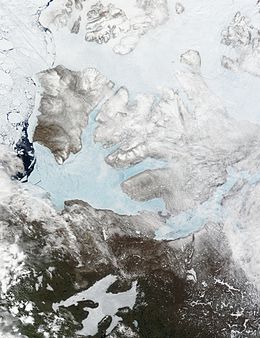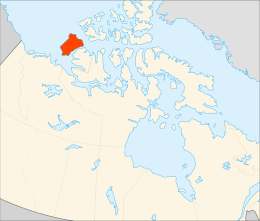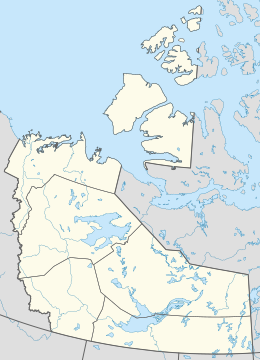 These moderate resolution imaging spectroradiometer images from June 14 and 16, 2002, show Banks Island (upper left) and Victoria Island (to the southeast) | |
 | |
| Geography | |
|---|---|
| Location | Beaufort Sea |
| Coordinates | 72°45′02″N 121°30′10″W / 72.75056°N 121.50278°W |
| Archipelago | Arctic Archipelago |
| Area | 70,028 km2 (27,038 sq mi) |
| Area rank | 24th |
| Length | 380 km (236 mi) |
| Width | 290 km (180 mi) |
| Highest elevation | 730 m (2400 ft) |
| Highest point | Durham Heights |
| Administration | |
Canada | |
| Territory | Northwest Territories |
| Largest settlement | Sachs Harbour (pop. 103) |
| Demographics | |
| Population | 103 (2016[1]) |
| Pop. density | 0.0016/km2 (0.0041/sq mi) |
Banks Island is one of the larger members of the Arctic Archipelago. Situated in the Inuvik Region, and part of the Inuvialuit Settlement Region, of the Northwest Territories, it is separated from Victoria Island to its east by the Prince of Wales Strait and from the mainland by Amundsen Gulf to its south. The Beaufort Sea lies to its west, and to its northeast M'Clure Strait separates the island from Prince Patrick Island and Melville Island.
It is home to at least fourteen mammal species including the Peary caribou, barren-ground caribou, and polar bears. At one time over 68,000 muskoxen lived on the island, the majority of the world's population. However, the bacterium Erysipelothrix rhusiopathiae has led to a sharp decline in their numbers. The island is the summer home to hundreds of thousands of migratory birds who nest at Banks Island Migratory Bird Sanctuary No. 1 and Banks Island Migratory Bird Sanctuary No. 2.[2][3]
As of the 2016 census it had a human population of 103, all in Sachs Harbour.[1]
- ^ a b "Census Profile, 2016 Census Sachs Harbour, Hamlet [Census subdivision], Northwest Territories and Northwest Territories [Territory]". 2016 Census. Statistics Canada.
- ^ "Banks Island Migratory Bird Sanctuary No. 1". Environment and Climate Change Canada. 2022-06-03.
- ^ "Banks Island Migratory Bird Sanctuary No. 2". Environment and Climate Change Canada. 2019-11-14.

